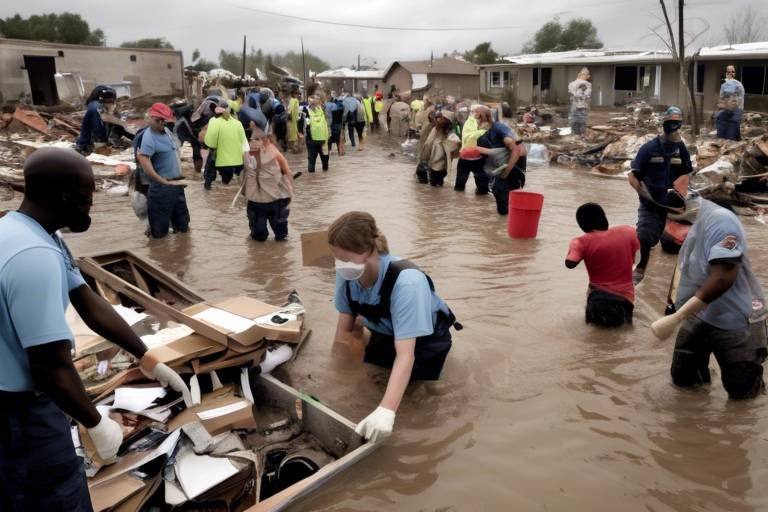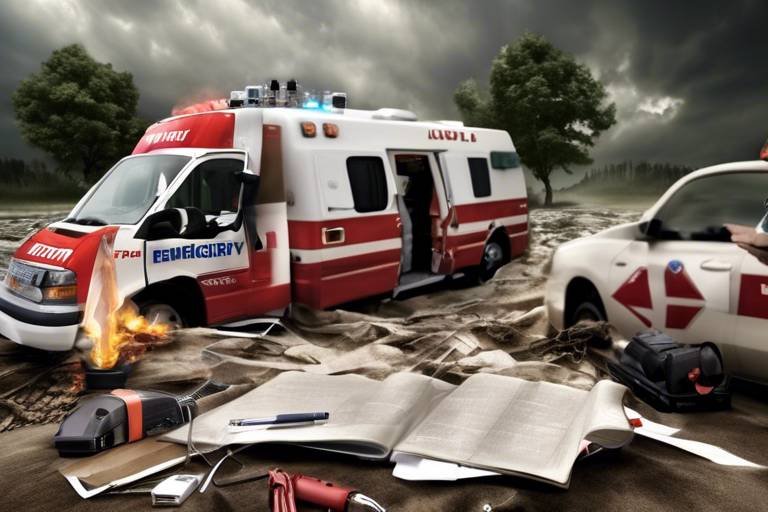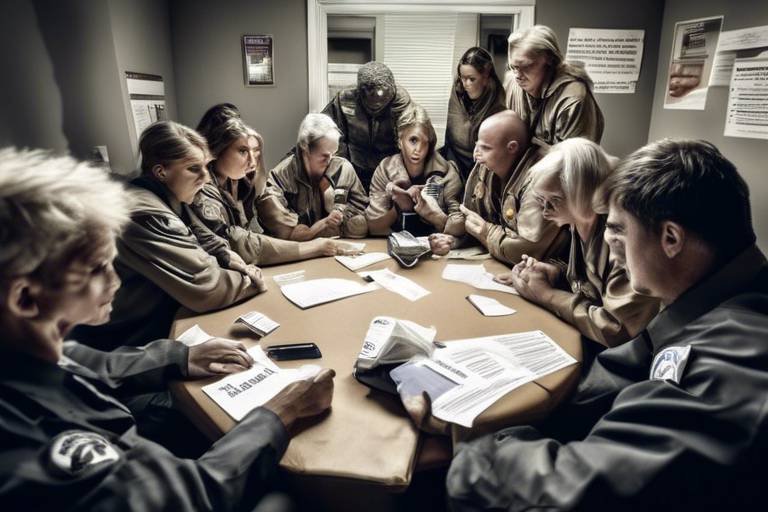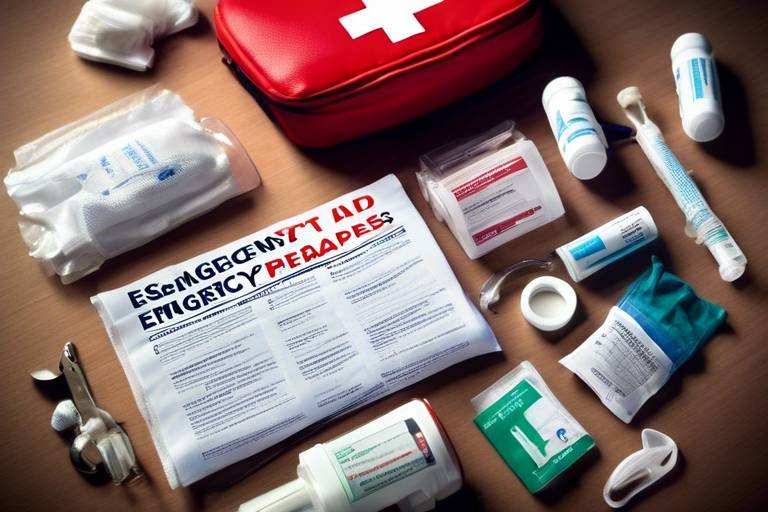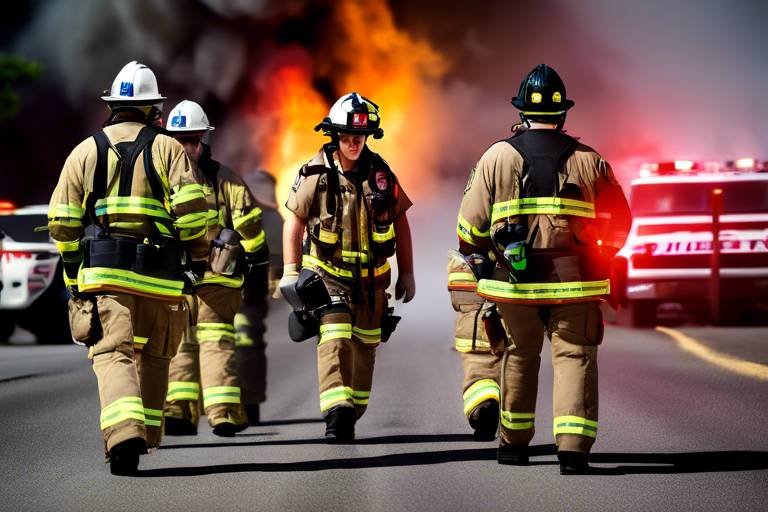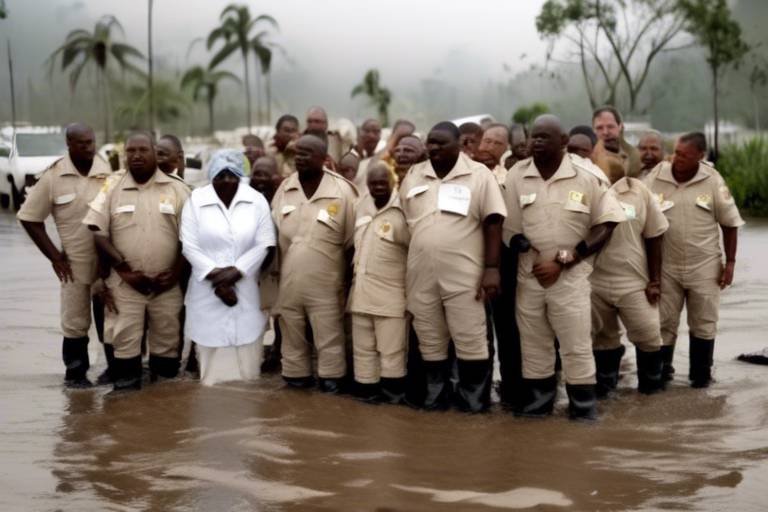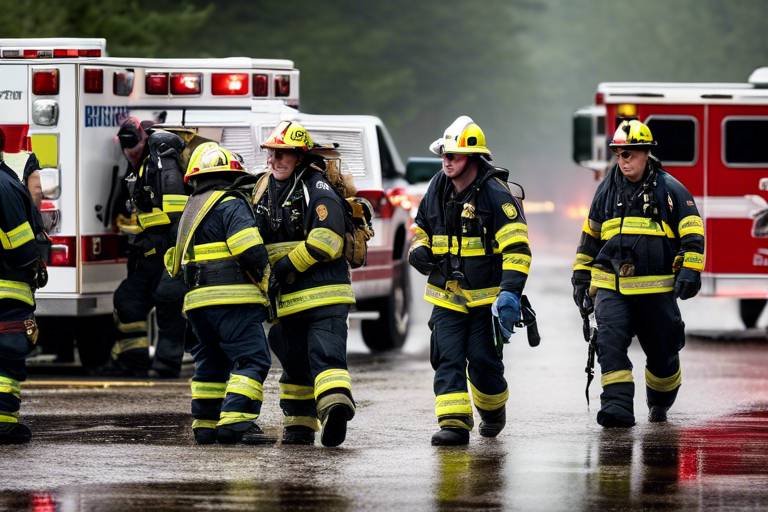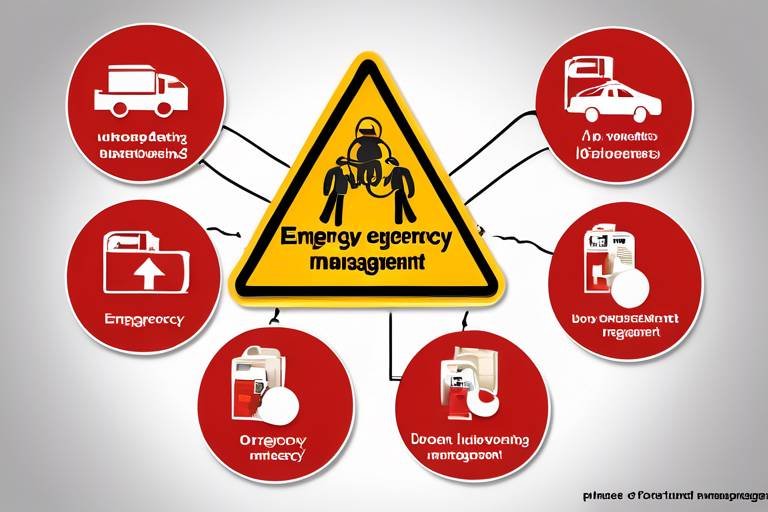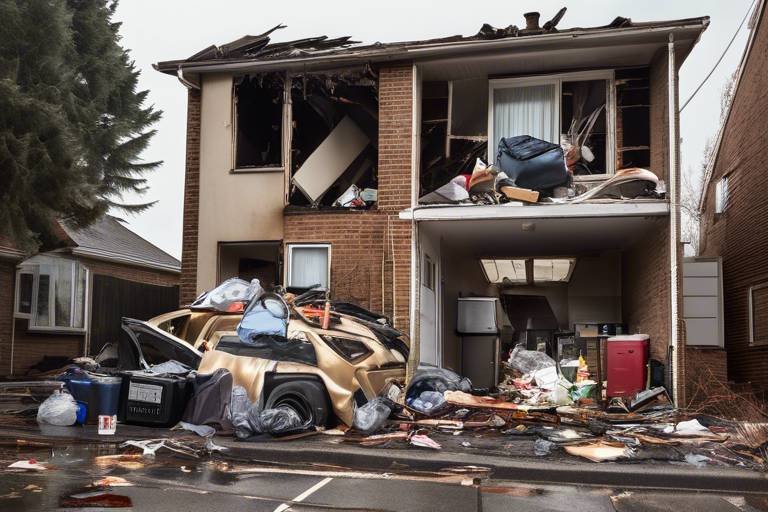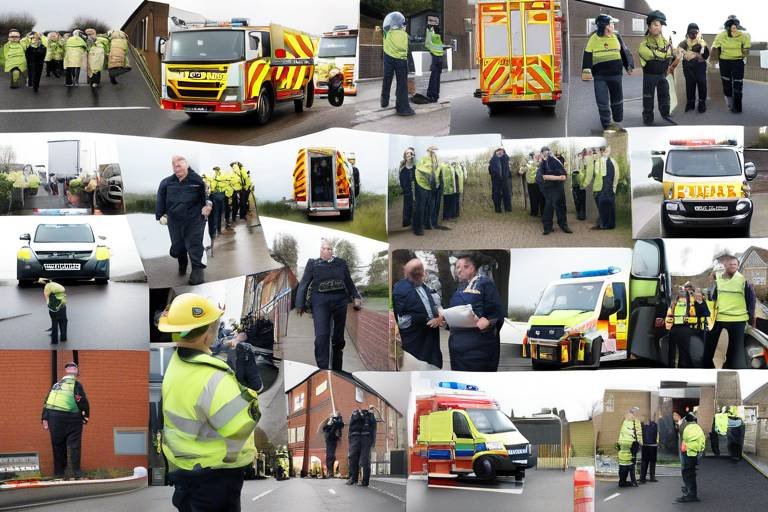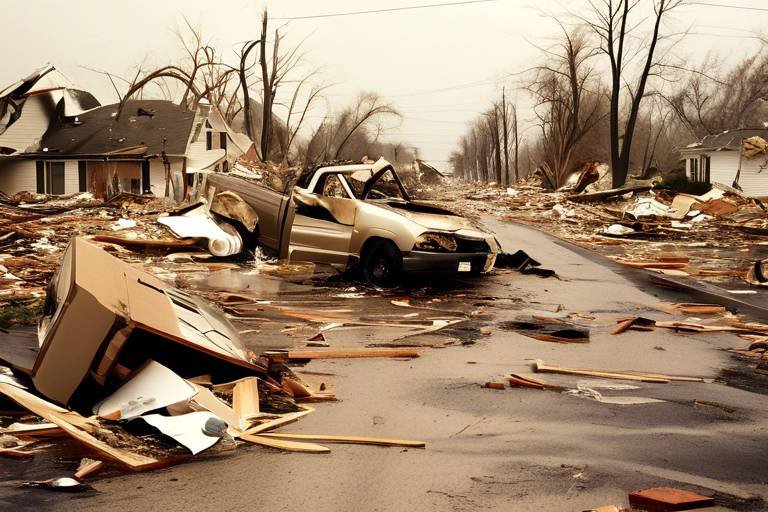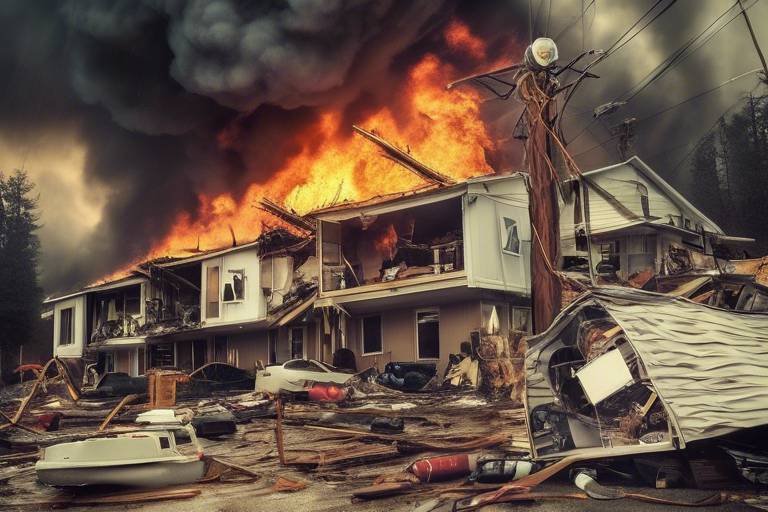Role of Non-Profits in Disaster Response and Recovery
In times of crisis, when the world feels like it's turned upside down, non-profit organizations emerge as beacons of hope and resilience. Their critical functions in disaster response and recovery are not just important; they are essential. From the moment disaster strikes, these organizations spring into action, ready to provide support, resources, and a sense of community. They play a multifaceted role that includes preparedness, immediate response, and long-term recovery, all while collaborating with various entities to ensure that aid reaches those who need it most. But how exactly do they do this? Let’s dive deeper into their impactful contributions.
Non-profits are often the unsung heroes of disaster preparedness. They take on the crucial task of educating communities about potential risks and the necessary steps to mitigate them. Think of them as the first line of defense against disasters. Through workshops, training sessions, and community outreach, these organizations empower individuals to create their own emergency plans. They provide resources that include everything from first aid kits to evacuation routes, ensuring that communities are not left in the dark when disaster strikes.
Moreover, non-profits often collaborate with local governments to develop comprehensive emergency plans. This partnership helps to identify vulnerable populations and tailor preparedness efforts to meet their specific needs. For instance, a non-profit might focus on creating accessible communication strategies for the elderly or individuals with disabilities, ensuring that everyone is included in the safety net.
When disaster hits, the clock starts ticking, and non-profits are known for their rapid response. They mobilize quickly, often within hours, to provide essential services such as food, shelter, and medical aid. Imagine a community where homes are destroyed, and families are displaced—this is where non-profits step in, offering not just physical support but also emotional reassurance. Their teams are trained to assess needs swiftly and deploy resources effectively, ensuring that those affected receive immediate assistance during the most critical moments.
Non-profits don't operate in isolation; they often collaborate with government agencies to enhance disaster response efforts. This partnership is essential for creating a coordinated response framework. By leveraging each other's strengths, they can ensure that aid is not only timely but also comprehensive.
One of the most effective ways to prepare for disasters is through joint training exercises. These exercises involve both non-profit organizations and government agencies working together to simulate disaster scenarios. The goal is to improve readiness and ensure that both parties are equipped to respond efficiently during a disaster. By practicing together, they can identify potential gaps in their response strategies and develop solutions before a real crisis occurs.
Resource sharing initiatives between non-profits and government entities also facilitate quicker mobilization of aid. For example, if a non-profit has a surplus of food supplies, they can coordinate with local government shelters to distribute these resources effectively. This kind of collaboration allows for a more comprehensive approach to disaster relief, ensuring that no one is left behind.
One of the most remarkable aspects of non-profits is their ability to engage local communities and mobilize volunteers. They foster a spirit of solidarity and collective action that is crucial for effective disaster response. When a disaster strikes, it’s often the community members who know their neighbors best, and non-profits harness this knowledge by training volunteers to assist in various capacities.
This grassroots approach not only increases the efficiency of the response but also empowers individuals to take an active role in their recovery. Volunteers often become the lifeblood of recovery efforts, providing everything from emotional support to logistical assistance.
After the immediate crisis has passed, non-profits play an instrumental role in long-term recovery efforts. They help communities rebuild infrastructure, restore livelihoods, and provide mental health support to those affected. It’s not just about putting roofs over heads; it’s about restoring hope and rebuilding lives.
Non-profits often take the lead in securing funding and allocating resources effectively. They understand that recovery efforts need to be sustainable and tailored to meet the unique needs of the community. This could involve everything from securing grants for rebuilding homes to providing job training programs for those who lost their livelihoods.
Beyond immediate aid, non-profits also advocate for policy changes that strengthen disaster response frameworks. They ensure that the needs of vulnerable populations are prioritized and addressed in future disaster planning. Advocacy work can lead to significant changes in how governments prepare for and respond to disasters, ultimately saving lives and resources in the long run.
- What role do non-profits play in disaster preparedness? Non-profits educate communities, provide resources, and develop emergency plans to mitigate the impact of disasters.
- How do non-profits respond to disasters? They mobilize quickly to provide essential services such as food, shelter, and medical aid.
- Do non-profits work with government agencies? Yes, non-profits often collaborate with government agencies to enhance disaster response efforts.
- What is the importance of community engagement in disaster response? Engaging local communities fosters solidarity and mobilizes volunteers, which is crucial for effective disaster response.
- How do non-profits assist in long-term recovery? They help rebuild infrastructure, restore livelihoods, and provide mental health support, ensuring sustainable recovery efforts.

Importance of Non-Profits in Disaster Preparedness
This article explores the critical functions that non-profit organizations serve in disaster situations, highlighting their roles in preparedness, response, recovery, and rebuilding efforts, as well as their collaboration with other entities.
When it comes to disaster preparedness, non-profit organizations are the unsung heroes that often work behind the scenes to ensure communities are ready for the unexpected. They don’t just react when disaster strikes; they proactively educate communities on how to prepare for potential emergencies. Imagine a community where residents are equipped with knowledge and resources—this is the vision that non-profits strive to achieve.
One of the primary ways non-profits contribute to disaster preparedness is through education and training programs. These programs can range from workshops on emergency response to information sessions about creating family disaster plans. By conducting these initiatives, non-profits empower individuals with the skills needed to respond effectively when disaster looms. They often collaborate with local schools, businesses, and community centers to spread awareness and ensure that information reaches every corner of the community.
In addition to education, non-profits also provide essential resources that can make a significant difference during a disaster. This can include distributing emergency kits that contain food, water, first aid supplies, and other necessities. Furthermore, they help establish emergency plans that outline clear steps for action before, during, and after a disaster. These plans are critical as they serve as a roadmap for communities, guiding them through the chaos that often accompanies natural disasters.
Another vital aspect of non-profits’ role in disaster preparedness is their ability to foster community resilience. They often organize community drills and simulations that not only prepare individuals but also strengthen the bonds within the community. When people come together to practice their response to a disaster, they build trust and camaraderie, making the community more resilient overall. This collective effort is akin to a well-rehearsed orchestra; when each member knows their part, the performance is seamless, even under pressure.
Moreover, non-profits are adept at identifying the unique needs of vulnerable populations within communities. They tailor their preparedness efforts to ensure that everyone, including the elderly, disabled, and low-income families, is included in disaster planning. This targeted approach is crucial because, as we know, disasters do not affect everyone equally. By addressing these disparities, non-profits ensure that no one is left behind when the next disaster strikes.
To illustrate the impact of non-profits in disaster preparedness, consider the following table that outlines key activities and their benefits:
| Activity | Benefit |
|---|---|
| Education Workshops | Empowers individuals with knowledge and skills |
| Resource Distribution | Provides essential supplies to those in need |
| Community Drills | Enhances community cohesion and readiness |
| Targeted Programs for Vulnerable Populations | Ensures inclusivity in disaster preparedness |
In conclusion, the importance of non-profits in disaster preparedness cannot be overstated. They serve as a bridge between knowledge and action, ensuring that communities are not only informed but also equipped to handle emergencies. Their efforts in education, resource provision, and community engagement create a safety net that can significantly reduce the impact of disasters. As we look to the future, fostering partnerships between non-profits, local governments, and community members will be essential in building resilient communities that can withstand the storms ahead.
- What role do non-profits play in disaster preparedness? Non-profits educate communities, provide resources, and create emergency plans to prepare for potential disasters.
- How do non-profits ensure inclusivity in their programs? They tailor their initiatives to meet the needs of vulnerable populations, ensuring everyone has access to preparedness resources.
- Can I volunteer with a non-profit for disaster preparedness? Absolutely! Many non-profits welcome volunteers to help with education, training, and resource distribution.

Immediate Response Efforts by Non-Profits
When disaster strikes, time is of the essence, and that's where non-profit organizations shine like beacons of hope. These dedicated entities mobilize at lightning speed to provide essential services that can mean the difference between life and death for affected individuals and communities. Imagine a city engulfed in chaos after a natural disaster; amidst the rubble, non-profits are often the first to arrive, equipped with resources, compassion, and a mission to help. They are not just responders; they are lifelines.
One of the most critical aspects of their immediate response efforts is the provision of food, shelter, and medical aid. Non-profits quickly set up emergency shelters, distribute food and water, and offer medical assistance to those in need. For instance, organizations like the Red Cross and local food banks work tirelessly to ensure that no one goes hungry or without a safe place to sleep. Their ability to assess the needs of the community and act swiftly is a testament to their training and commitment.
In addition to these on-the-ground efforts, non-profits often employ innovative strategies to maximize their impact. For example, they utilize technology to coordinate relief efforts, track supplies, and communicate with volunteers. This tech-savvy approach not only streamlines operations but also enhances the overall efficiency of the response. Moreover, many non-profits leverage social media platforms to raise awareness and gather support, turning ordinary citizens into volunteers and donors.
Collaboration is another cornerstone of non-profit response efforts. They often work hand-in-hand with local governments, businesses, and other organizations to create a unified front against disaster. This synergy allows for a more comprehensive response, ensuring that all aspects of the crisis are addressed. For instance, during Hurricane Katrina, numerous non-profits collaborated with government agencies to provide immediate relief and rebuild affected communities.
To illustrate the impact of non-profits in disaster response, consider the following table that highlights key services provided during a recent disaster:
| Non-Profit Organization | Service Provided | Number of People Served |
|---|---|---|
| Red Cross | Emergency Shelters | 5,000+ |
| Feeding America | Food Distribution | 10,000+ |
| Doctors Without Borders | Medical Aid | 2,000+ |
In summary, the immediate response efforts of non-profits are crucial in disaster situations. Their ability to mobilize quickly, provide essential services, and collaborate with various entities not only saves lives but also restores hope in the aftermath of chaos. As we continue to face natural disasters and emergencies, the role of non-profits will undoubtedly remain indispensable.
- What types of disasters do non-profits respond to? Non-profits respond to various disasters, including natural disasters like hurricanes, earthquakes, floods, and man-made crises such as industrial accidents and conflicts.
- How can I help non-profits during a disaster? You can help by donating money, volunteering your time, or providing supplies. Many organizations also have specific needs listed on their websites.
- Are non-profits effective in disaster response? Yes, non-profits are often effective due to their experience, community connections, and ability to mobilize resources quickly.

Collaboration with Government Agencies
When a disaster strikes, the clock is ticking, and every moment counts. Non-profit organizations are often on the front lines, but their impact is significantly amplified when they collaborate with government agencies. This partnership is not just about sharing resources; it's about creating a cohesive response strategy that combines the strengths of both sectors. Think of it as a well-rehearsed dance, where each partner knows their steps and moves in harmony to address the urgent needs of affected communities.
One of the primary benefits of this collaboration is the pooling of resources. Government agencies have access to funding, infrastructure, and logistical support, while non-profits bring local knowledge, agility, and dedicated volunteers. Together, they can develop comprehensive disaster response plans that are both effective and efficient. For instance, during Hurricane Katrina, the collaboration between non-profits and government entities was crucial in delivering aid to those stranded in the chaos. By working together, they were able to establish shelters, distribute food, and provide medical services much faster than if they had operated independently.
Moreover, joint training exercises play a vital role in enhancing this collaborative effort. When non-profits and government agencies engage in simulated disaster scenarios, they can identify gaps in their response strategies and improve their operational readiness. These exercises allow both parties to practice communication protocols, establish roles, and understand each other's capabilities. It’s like a team sport; you need to know your teammates' strengths and weaknesses to play effectively.
Resource sharing initiatives further enhance the effectiveness of disaster response. By sharing information, supplies, and personnel, non-profits and government agencies can mobilize aid more quickly. For example, during the COVID-19 pandemic, many non-profits collaborated with local health departments to distribute personal protective equipment (PPE) and educate communities about safety protocols. This synergy not only expedited the distribution of essential resources but also ensured that the information reached the most vulnerable populations.
In conclusion, the collaboration between non-profits and government agencies is not just beneficial; it is essential for effective disaster response. By leveraging each other's strengths, they can create a robust framework that not only addresses immediate needs but also paves the way for long-term recovery. This partnership exemplifies the power of collective action, reminding us that when we come together, we can achieve remarkable outcomes in the face of adversity.

Joint Training Exercises
Joint training exercises are a cornerstone of effective disaster response, bringing together non-profit organizations and government agencies to enhance their preparedness for potential crises. Imagine a well-orchestrated symphony where every musician knows their part and can seamlessly adapt to changes in tempo; that's the essence of these collaborative training sessions. They allow participants to practice their roles in a controlled environment, ensuring that when a real disaster strikes, the response is not only swift but also coordinated.
During these exercises, various scenarios are simulated, ranging from natural disasters like hurricanes and earthquakes to man-made emergencies such as chemical spills or terrorist attacks. This hands-on approach helps both non-profit staff and government responders understand the unique challenges they may face. By working together, they learn to communicate effectively, share resources, and establish clear lines of authority, which are crucial during actual emergencies.
Moreover, these exercises often include a variety of stakeholders—local businesses, community leaders, and even volunteers—creating a comprehensive network of support. The inclusion of diverse perspectives enriches the training, as each participant brings unique insights and expertise. For instance, a local business owner might share logistical strategies that non-profits can leverage for supply distribution, while a community leader could offer insights into the specific needs of vulnerable populations.
To illustrate the impact of joint training exercises, consider the following table that outlines key benefits:
| Benefit | Description |
|---|---|
| Improved Communication | Fosters better information sharing between organizations, ensuring everyone is on the same page during a disaster. |
| Resource Optimization | Enhances the ability to pool resources, preventing duplication of efforts and ensuring a more efficient response. |
| Enhanced Community Trust | Builds trust within the community as residents see organizations working together for their safety and well-being. |
| Increased Readiness | Participants leave training with a clearer understanding of their roles, leading to a more effective response when disasters occur. |
In conclusion, joint training exercises are not just about ticking boxes; they are about creating a culture of collaboration that can save lives. By preparing together, non-profits and government agencies ensure that they are not only ready to respond but also capable of adapting to the dynamic nature of disasters. As we continue to face an increasingly unpredictable world, the importance of these exercises cannot be overstated.
- What is the primary goal of joint training exercises?
The primary goal is to enhance coordination and preparedness between non-profits and government agencies during disaster response. - Who participates in these training exercises?
Participants typically include non-profit staff, government officials, local businesses, community leaders, and volunteers. - How often are these exercises conducted?
The frequency can vary, but many organizations aim to conduct exercises at least once a year to maintain readiness. - What types of scenarios are practiced?
Scenarios can range from natural disasters like floods and wildfires to public health emergencies and terrorist incidents.

Resource Sharing Initiatives
In the wake of a disaster, the need for quick and effective resource distribution becomes paramount. This is where come into play, acting as a lifeline for communities in distress. Non-profit organizations often find themselves at the forefront of these initiatives, collaborating with government agencies, local businesses, and other stakeholders to ensure that resources are utilized efficiently and effectively. By pooling resources, these entities can minimize waste and maximize impact, which is crucial when every minute counts.
One of the key benefits of resource sharing is the ability to quickly mobilize various forms of aid, whether it be food, medical supplies, or shelter. For instance, during a recent natural disaster, a coalition of non-profits and government agencies came together to create a centralized database of available resources. This database allowed them to track inventory in real-time, ensuring that aid could be dispatched to the areas that needed it most without delay. Imagine the chaos that could ensue if each organization operated in isolation; the result would be a disorganized scramble for resources, ultimately leaving many in need without assistance.
Moreover, resource sharing initiatives often include training programs for volunteers and local organizations. These programs ensure that everyone involved understands the logistics of resource distribution, from managing supplies to coordinating with emergency services. By empowering local volunteers with the necessary skills and knowledge, non-profits not only enhance the immediate response but also build a resilient community that can better withstand future disasters.
Another essential aspect of these initiatives is the establishment of partnerships with local businesses. For example, grocery stores may donate food nearing its expiration date, while pharmacies can provide medical supplies. This collaborative effort creates a network of support that extends beyond immediate relief. It allows communities to come together, fostering a sense of solidarity and shared responsibility. As the saying goes, "It takes a village," and in disaster response, this couldn't be more accurate.
To illustrate the effectiveness of resource sharing initiatives, consider the following table that outlines some successful examples:
| Disaster Type | Initiative | Outcome |
|---|---|---|
| Hurricane | Food and Shelter Coalition | Provided meals and temporary housing for over 5,000 individuals |
| Earthquake | Medical Supply Network | Distributed critical medical supplies to 20 clinics |
| Flood | Community Resource Center | Facilitated the donation of over $1 million in goods and services |
In conclusion, resource sharing initiatives are not just about distributing goods; they represent a fundamental shift towards collaboration and community resilience. By leveraging the strengths of various organizations and fostering partnerships, non-profits can create a more effective response framework that not only addresses immediate needs but also builds a foundation for long-term recovery. As we continue to face natural disasters and crises, the importance of these initiatives will only grow, reminding us that in times of need, we are stronger together.
- What are resource sharing initiatives? These are collaborative efforts between various organizations to pool resources for more effective disaster response.
- How do non-profits benefit from these initiatives? Non-profits can maximize their impact by sharing resources, reducing waste, and enhancing community engagement.
- Can individuals participate in resource sharing? Absolutely! Community members can volunteer, donate goods, or help coordinate efforts.

Community Engagement and Volunteer Mobilization
When disaster strikes, the strength of a community is often measured by its ability to come together in times of need. Non-profit organizations are at the forefront of this effort, playing a pivotal role in community engagement and the mobilization of volunteers. They act as a bridge, connecting individuals with opportunities to help, thereby fostering a sense of solidarity and collective action. This not only aids in immediate relief efforts but also strengthens the community fabric for future challenges.
One of the most remarkable aspects of non-profits is their ability to tap into the local populace's innate desire to help. They do this through various outreach programs and initiatives that inform and educate community members about the importance of disaster preparedness and response. By organizing workshops, training sessions, and informational campaigns, non-profits empower individuals to take action, transforming them from passive observers into active participants in their own recovery.
Moreover, non-profits excel in mobilizing volunteers quickly and efficiently. They have established networks and systems that allow them to coordinate volunteer efforts effectively. For instance, during a disaster, a non-profit might set up a volunteer command center where people can sign up to assist in various capacities, from distributing food and water to providing medical assistance or helping with clean-up efforts. The beauty of this mobilization is that it not only provides immediate assistance to those in need but also helps volunteers feel a sense of purpose and belonging.
To illustrate the impact of community engagement and volunteer mobilization, consider the following table that outlines the various roles volunteers can play during disaster response efforts:
| Volunteer Role | Description |
|---|---|
| First Responders | Trained volunteers who provide immediate medical assistance and support to affected individuals. |
| Logistics Support | Volunteers who help manage supplies, coordinate transportation, and ensure that resources reach those in need. |
| Community Outreach | Individuals who engage with affected populations to assess needs and provide information about available resources. |
| Emotional Support | Volunteers trained in mental health support who offer comfort and counseling to those experiencing trauma. |
In addition to immediate response roles, non-profits often focus on building long-term volunteer programs that encourage ongoing community involvement. This could mean organizing regular training sessions, creating mentorship programs, or even establishing partnerships with local schools and businesses to foster a culture of volunteerism. By doing so, non-profits not only enhance their disaster response capabilities but also cultivate a resilient community that is better prepared for future challenges.
Ultimately, the work of non-profits in community engagement and volunteer mobilization is a testament to the power of collective action. They remind us that in the face of adversity, we are stronger together. Whether it’s through a simple act of kindness or a coordinated effort to provide relief, every contribution counts. By nurturing this spirit of volunteerism, non-profits lay the groundwork for a more resilient future, proving that even in the darkest times, there is always a light of hope fueled by community solidarity.
- What types of disasters do non-profits respond to? Non-profits respond to a wide range of disasters including natural disasters like hurricanes, floods, and earthquakes, as well as human-made crises such as industrial accidents and pandemics.
- How can I get involved with a non-profit during a disaster? You can get involved by volunteering your time, donating resources, or participating in community preparedness programs organized by local non-profits.
- Are non-profits effective in disaster response? Yes, non-profits are often more agile and can mobilize quickly, making them highly effective in providing immediate assistance and long-term recovery support.
- How do non-profits collaborate with other organizations? Non-profits collaborate with government agencies, businesses, and other non-profits to share resources, coordinate efforts, and enhance the overall effectiveness of disaster response initiatives.

Long-Term Recovery and Rehabilitation Efforts
After the immediate chaos of a disaster subsides, the journey toward recovery begins, and this is where non-profit organizations truly shine. They step in as the backbone of long-term recovery efforts, helping communities not just to survive, but to thrive once again. Imagine a community that has lost everything; non-profits are like the architects of hope, laying down the first bricks of rebuilding. They assist in restoring vital infrastructure, such as schools and hospitals, which are crucial for community stability. Without these essential services, the path to recovery can feel like an uphill battle, but non-profits are there to ease the burden.
One of the key areas where non-profits excel is in restoring livelihoods. They provide training programs and resources that help individuals regain their economic footing. For instance, after a natural disaster, many people lose their jobs or businesses. Non-profits often step in with initiatives that offer job training, financial literacy courses, and even grants to help small businesses get back on their feet. This not only aids in personal recovery but also contributes to the economic revitalization of the entire community.
Additionally, mental health support is another critical component of long-term recovery efforts. Disasters can leave emotional scars that linger long after the physical damage is repaired. Non-profits often provide counseling services and support groups to help individuals process their trauma. They create safe spaces for people to share their experiences and support one another, fostering a sense of community and resilience. The ripple effect of mental health support is profound; when individuals feel supported, they are more likely to contribute positively to their community's recovery.
To ensure that recovery efforts are sustainable, non-profits often engage in funding and resource allocation. They work tirelessly to secure donations, grants, and partnerships that allow them to effectively distribute resources where they are needed most. This involves a meticulous process of assessing community needs and aligning them with available resources. For example, if a community is in desperate need of housing, non-profits will prioritize funding for rebuilding homes over other initiatives. This strategic approach ensures that every dollar spent has the maximum impact on recovery.
Moreover, non-profits play a pivotal role in advocating for policy changes that strengthen disaster response frameworks. They act as the voice for vulnerable populations, ensuring that their needs are prioritized in future disaster planning. This advocacy is crucial because it not only addresses immediate concerns but also influences long-term strategies that can prevent future disasters from having the same devastating effects. By working with local governments and other stakeholders, non-profits help to shape policies that promote resilience within communities.
In conclusion, the role of non-profits in long-term recovery and rehabilitation is indispensable. They are the unsung heroes who work behind the scenes, tirelessly rebuilding lives and communities. Their efforts in restoring infrastructure, supporting livelihoods, providing mental health services, and advocating for policy changes create a robust framework for recovery that benefits everyone involved. As we reflect on the importance of these organizations, it’s clear that their contributions not only help communities recover but also empower them to emerge stronger than before.
- What types of support do non-profits provide during long-term recovery? Non-profits provide a range of support, including infrastructure rebuilding, job training, mental health services, and advocacy for policy changes.
- How do non-profits secure funding for recovery efforts? Non-profits often secure funding through donations, grants, and partnerships with businesses and government entities.
- Why is mental health support important in disaster recovery? Mental health support is crucial as it helps individuals cope with trauma, fostering resilience and community solidarity during the recovery process.
- How can individuals get involved with non-profits during recovery efforts? Individuals can volunteer their time, donate resources, or help raise awareness about the non-profits’ efforts in their community.

Funding and Resource Allocation
This article explores the critical functions that non-profit organizations serve in disaster situations, highlighting their roles in preparedness, response, recovery, and rebuilding efforts, as well as their collaboration with other entities.
Non-profits play a vital role in disaster preparedness by educating communities, providing resources, and establishing emergency plans to mitigate the impact of disasters before they occur.
During disasters, non-profits mobilize quickly to provide essential services such as food, shelter, and medical aid, ensuring that affected populations receive immediate assistance in times of crisis.
Non-profits often collaborate with government agencies to enhance disaster response efforts, leveraging each other's strengths to create a more effective and coordinated response framework.
Joint training exercises between non-profits and government agencies improve readiness and ensure that both parties are equipped to respond efficiently during a disaster.
Resource sharing initiatives between non-profits and government entities facilitate quicker mobilization of aid, allowing for a more comprehensive approach to disaster relief.
Non-profits excel at engaging local communities and mobilizing volunteers, fostering a spirit of solidarity and collective action that is crucial for effective disaster response.
After the immediate crisis, non-profits are instrumental in long-term recovery efforts, helping communities rebuild infrastructure, restore livelihoods, and provide mental health support to those affected.
One of the most significant roles that non-profits play in disaster recovery is their ability to secure funding and allocate resources effectively. In the aftermath of a disaster, financial aid is crucial. Non-profits often work tirelessly to gather donations from individuals, corporations, and foundations. They tap into a variety of funding sources, including grants from government agencies, private donations, and crowdfunding campaigns. This diverse funding base enables them to operate flexibly and respond to the unique needs of affected communities.
Moreover, non-profits are adept at resource allocation. They assess the immediate needs of the community and prioritize where funds and supplies should be directed. For instance, if a community has been devastated by a hurricane, non-profits might allocate resources towards rebuilding homes, providing food and water, and offering mental health services. This strategic allocation not only addresses urgent needs but also sets the stage for sustainable recovery.
To illustrate the importance of funding and resource allocation, consider the following table that outlines various funding sources and their impact:
| Funding Source | Description | Impact |
|---|---|---|
| Government Grants | Financial support from local, state, or federal agencies. | Enables large-scale recovery projects and infrastructure rebuilding. |
| Private Donations | Contributions from individuals and businesses. | Provides immediate assistance and supplies to affected individuals. |
| Crowdfunding | Online fundraising campaigns initiated by non-profits. | Engages the community and raises awareness while generating funds. |
Ultimately, the effective management of funds and resources by non-profits not only accelerates recovery efforts but also fosters trust within the community. When people see their donations being utilized efficiently, they are more likely to contribute in the future, creating a sustainable cycle of support. This is particularly important in a world where disasters are becoming increasingly frequent and severe.
- What types of disasters do non-profits respond to? Non-profits respond to various disasters, including natural disasters like hurricanes, earthquakes, and floods, as well as man-made crises such as conflicts and pandemics.
- How can I help non-profits during a disaster? You can help by donating money, volunteering your time, or spreading awareness about their efforts through social media.
- Are non-profits effective in disaster recovery? Yes, non-profits are often on the front lines of disaster recovery, providing essential services and support to affected communities.

Advocacy for Policy Changes
Non-profit organizations are not just the first responders during disasters; they also play an essential role in shaping the policies that govern disaster response and recovery. Through their advocacy efforts, these organizations push for changes that can significantly enhance the effectiveness of disaster management frameworks. Imagine a community that has just faced a devastating hurricane. The immediate needs are clear—food, shelter, and medical aid. However, the long-term needs often get overshadowed by the chaos of the moment. This is where non-profits step in, not only to provide immediate relief but also to ensure that the lessons learned during the disaster lead to meaningful policy changes.
One of the key areas where non-profits focus their advocacy efforts is on the inclusion of vulnerable populations in disaster planning. They understand that certain groups—such as the elderly, disabled individuals, and low-income families—often suffer disproportionately during disasters. By highlighting these disparities, non-profits can advocate for policies that prioritize the needs of these communities, ensuring that future disaster response efforts are equitable and effective.
In addition, non-profits often collaborate with a variety of stakeholders, including local governments, businesses, and community organizations, to create a unified voice for change. This collaborative approach not only strengthens their advocacy efforts but also fosters a sense of community ownership over disaster preparedness and recovery strategies. For example, when non-profits partner with local governments, they can influence policy changes that incorporate community feedback, making disaster response plans more reflective of the actual needs on the ground.
Furthermore, non-profits engage in extensive research and data collection to support their advocacy initiatives. They gather evidence on the effectiveness of current policies and identify gaps that need addressing. This data-driven approach allows them to present compelling arguments to policymakers, ensuring that their recommendations are not just based on anecdotes but are grounded in solid research. For instance, a non-profit might compile statistics showing how certain neighborhoods are more vulnerable to flooding due to inadequate infrastructure, thereby advocating for specific changes to local building codes or zoning laws.
To illustrate the impact of non-profit advocacy, consider the following table that outlines some successful policy changes influenced by non-profit organizations:
| Policy Change | Description | Non-Profit Involved |
|---|---|---|
| Increased Funding for Emergency Services | Advocated for a budget increase to improve local emergency services. | Community Action Network |
| Inclusive Disaster Planning | Implemented policies to ensure the inclusion of vulnerable populations in disaster response plans. | Equity in Disaster Relief |
| Improved Infrastructure Standards | Advocated for stricter building codes to withstand extreme weather events. | Safe Homes Initiative |
In conclusion, the advocacy efforts of non-profits are vital in ensuring that disaster response policies are not only effective but also inclusive and equitable. By championing the needs of vulnerable populations and leveraging data to influence policy changes, non-profits are paving the way for a more resilient future. Their work does not end when the immediate crisis passes; instead, it evolves into a long-term commitment to improving disaster management systems for everyone.
- What role do non-profits play in disaster preparedness?
Non-profits educate communities, provide resources, and develop emergency plans to mitigate the impact of disasters. - How do non-profits respond during disasters?
They mobilize quickly to provide essential services such as food, shelter, and medical aid to those in need. - Why is collaboration between non-profits and government agencies important?
Collaboration enhances the effectiveness of disaster response efforts by leveraging the strengths of both entities. - What is the significance of community engagement?
Community engagement fosters solidarity and mobilizes volunteers, which are crucial for effective disaster response. - How do non-profits contribute to long-term recovery?
They help rebuild infrastructure, restore livelihoods, and provide mental health support to affected individuals.
Frequently Asked Questions
-
What role do non-profits play in disaster preparedness?
Non-profits are crucial in disaster preparedness as they educate communities about potential risks and provide resources to help mitigate those risks. They also work on establishing emergency plans that can be activated when disasters strike, ensuring that communities are better equipped to handle such situations.
-
How do non-profits respond during a disaster?
During a disaster, non-profits mobilize quickly to deliver essential services, including food, shelter, and medical aid. Their rapid response is vital in ensuring that affected populations receive the immediate help they need, often working around the clock to provide support in times of crisis.
-
Do non-profits collaborate with government agencies?
Absolutely! Non-profits often collaborate with government agencies to enhance disaster response efforts. By leveraging each other's strengths, they can create a more effective and coordinated response framework that benefits the community as a whole.
-
What are joint training exercises?
Joint training exercises are collaborative sessions where non-profits and government agencies come together to practice their disaster response strategies. These exercises improve readiness and ensure that both parties are equipped to respond efficiently during an actual disaster.
-
How do non-profits engage local communities during disasters?
Non-profits excel at engaging local communities by mobilizing volunteers and fostering a spirit of solidarity. They create opportunities for community members to participate in disaster response efforts, which is crucial for effective and collective action in times of need.
-
What happens after the immediate crisis?
After the immediate crisis, non-profits play a significant role in long-term recovery and rehabilitation efforts. They help communities rebuild infrastructure, restore livelihoods, and provide mental health support to those affected, ensuring a holistic approach to recovery.
-
How do non-profits secure funding for recovery efforts?
Non-profits often secure funding through grants, donations, and partnerships with other organizations. They allocate these resources effectively to ensure that recovery efforts are sustainable and meet the specific needs of the communities they serve.
-
What kind of policy changes do non-profits advocate for?
Non-profits advocate for policy changes that strengthen disaster response frameworks. This includes ensuring that the needs of vulnerable populations are prioritized in future disaster planning, ultimately leading to more effective and inclusive disaster management.

